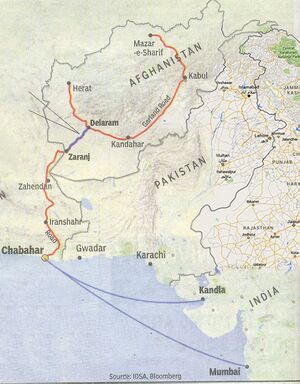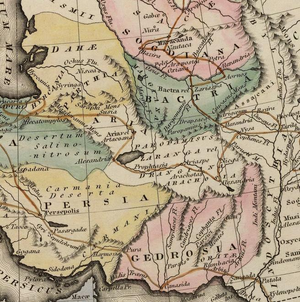Iranshahr


Iranshahr (Hindi:ईरान शहर, Persian: ايرانشهر) is a city and capital of Iranshahr County, in Sistan and Baluchestan Province, Iran. Its ancient name was Pura.
Location
It is located on Chabahar-Zaranj-Delaram Highway.
Variants of name
- Īrānshahr (Romanized)
- Fahraj
- Fahrej
- Fehruj
- Kalah Nasseri
- Pahrah
- Paharu
- Pahura
- Poora
- Poorah
- Poura
- Puhra
- Pura
- Purapura (पुरपुर) - Mentioned in Rajatarangini: Book VIII (p.82)
- Qal‘eh-ye Nāşerī
Origin of name
Jat clans
People
The city is predominantly inhabited by ethnic Baloch speaking the Balochi language.
History
Before 1935 the city was called Pahrah (Persian: پهره), also spelt Poora, Poorah, and Pura. The name was changed to Iranshahr by Mohammad Reza Shah Pahlavi in about 1937.
Pahrah is the site where Alexander the Great celebrated and regrouped his troops after his Indian conquests. The city used to be the center of the government of Balochistan and has been invaded and conquered numerous times during the course of its history. Bampur, where the ancient Bampur fort is located, is nearby.
Fahraj, which in 1911 had a population of about 2,500, has become more important than Bampur. Fahraj, which is also known as Pahura (or Paharu or Puhra), is by some identified as the Poura where Alexander the Great halted on his march from the Indus region of Pakistan. Others are more in favour of another Fahraj near Bam, or even of Bampūr itself as the halting place of Alexander the Great [1]
Bampur is a site of some of the burial urns with human facial features called 'Visage Urns'. They are reported from either few Palestinian caves of the 4th millenium B.C. or from Khurab, Bampur and Katukan in Persian Makran of 2nd-1st millenium B.C.[2]
The old citadel of Bampur, on a hill about 100 feet high 3 miles north of the river, fell into ruins. A new fort called Kalah Nasseri, was built at Pahrah, which is known as Iranshahr, 24 km further east, in the 1880s.[3]
Al Idrísí[4] towards the end of the 11th century has described towns which include ....From Mansúria to Túbarán, about fifteen days. ....Túbaran (Túrán) is near Fahraj, which belongs to Kirmán. It is a well fortified town, and is situated on the banks of a river of the same name (Túbarán), which are cultivated and fertile. From hence to Fardán, a commercial town, the environs of which are well populated
Purapura in Rajatarangini
Purapura (पुरपुर) is mentioned in Rajatarangini: Book VIII (p.82).
Rajatarangini[5] tells that ....In order to attack Sussala, the king Bhikshachara sent Vimba with an army to Lohara by the Rajapuri road. After Vismaya of Sallara had become his friend, the king, accompanied with Somapala, brought an army of Turushka to aid Vimba ; and to every individual Turushka he showed a cord and said that he would bind and drag Sussala with it....the king lost his support and his wealth was gone....and Sussala becomes king second time in 1121 AD.
Rajatarangini[6] tells that ....Leaving Kashmira, Bhikshu with Prithvihara and others went to the village of Pushpānaḍa which was in the possession of Somapala. The king went and subdued all the Damaras and placed Malla, son of Vatta, at Kheri and Harshamitra at Kampana. Those who had heedlessly acted against him did not receive his mercy now. The king Sussala was extremely jealous of Bhikshu and could not brook any trace of him, and bestowed the country in small portions on his own servants. ...Bhikshu, deprived of his kingdom, lived in the possession, of his friend Somapala and was encouraged by the gifts and the honor bestowed on him by his host. Vimba, with a view to obtain help, went to Vismaya, and was there surrounded by his enemies and fell fighting. On the death of Vimba, Bhikshachayra adopted the policy of taking Vimba's wife into his family and felt no shame. The hero Prithvihara fell on Purapura, and though he had a small army, he defeated the son of Vatta and made him flee from battle. When he had fled, Prithvi brought out Bhikshu again, and, at the desire of his wild followers, entered Madava. Joined by Marikha, Yajya and other Damaras who dwelt there, he marched to Vijayakshetra in order to overcome the lord of Kampana.
References
- ↑ (Chisholm 1911).
- ↑ Dr Naval Viyogi: Nagas – The Ancient Rulers of India,p.68
- ↑ "Bampūr". Encyclopædia Britannica 3 (11th ed.). Cambridge University Press.
- ↑ The History of India, as Told by Its Own Historians/VIII. Al Idrísí ,p.81
- ↑ Book VIII (p.76-77)
- ↑ Book VIII (p.82-83)
Back to Jat Places in Iran

